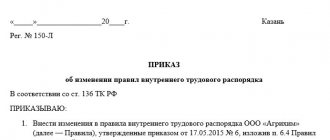What it is
To accurately calculate the hourly tariff rate in 2020, you need to consider:
- employee's monthly salary;
- type of workweek (5-day or 6-day, 40-, 36- or 24-hour);
- number of working hours in 2020
For reference, the most common type of workweek is 5 days, 8 hours a day. Teachers, service workers, and some other categories work 6 days a week, but their total working time per week will be 40 hours (usually their work schedule in hours is as follows: 7 + 7 + 7 + 7 + 7 + 5 = 40).
Regarding the duration of a 5-day work week:
- Adolescents under 16 years of age and employees of production facilities producing chemical weapons should work no more than 24 hours a week;
- no more than 36 hours a week - teachers, workers in industries with harmful and dangerous working conditions, etc.
Medical workers, depending on their position and specialty, have a 24-, 30-, 33-, and 36-hour work week.
Tariff rate
According to Art. 129 of the Labor Code of the Russian Federation, the tariff rate is a fixed amount of remuneration for performing certain work during a unit of time, without taking into account compensation, incentives and social payments to the employee. Tariff rates can be calculated per month, day, or hour.
The monthly tariff rate (or salary) does not depend on the number of working days or hours in a particular month - the salary is always calculated in the amount of the salary if all working days of the month are fully worked. Moreover, it does not matter that there may be more working days in one month than in another, this does not affect the amount of earnings.
The daily tariff rate is applied if the length of the working day is always the same, but the number of working days in a month differs from the established norms.
An hourly rate may be needed when calculating payment for hours worked is required, namely:
- to calculate earnings with a shift work schedule and summarized recording of working hours,
- to calculate wages for overtime work,
- for pay for night work,
- to calculate wages on weekends and holidays,
- to pay for work in harmful and dangerous conditions.
How to calculate
Let's consider 2 calculation options: for 40 and 24 hours of work per week. To calculate the hourly tariff rate from the hourly salary, the formula is used:
Example 1: 40 hours per week.
Let’s say a proofreader at a publishing house works 5 days a week, 8 hours a day.
Salary - 20,000 rubles per month.
The number of working hours in 2020 at 40 working hours per week is 1970.
Hourly tariff formula: 20,000 × 12 /1970 = 121.82 rubles.
Example 2. 24 hours a week.
A 15-year-old teenager works as a courier for a publishing house.
Salary - 15,000 rubles per month.
The number of working hours in 2020 with a 24-hour work week is 1179.6.
Formula for calculating the hourly tariff rate for 2020: 15,000 × 12 / 1179.6 = 152.5 rubles.
In organizations that use summarized working time tracking, average hourly earnings are used to calculate the average earnings of a specific employee.
[p.265] If one or more months of the billing period are not fully worked, the average hourly earnings are determined by dividing the amount of accrued wages in the billing period by the sum of the average monthly number of working hours of fully worked months and the number of working hours according to the schedule [p.267] Average hourly earnings = 6385 17000 = 0.376 rubles. [p.107]
Average hourly earnings are obtained by dividing the hourly wage fund by the number of man-hours worked. Average daily earnings can be obtained from hourly earnings multiplied by the number of hours worked. days and the coefficient of additional payments to daily earnings. Average monthly earnings can be obtained by multiplying daily earnings by the length of the working month and by the coefficient of additional payments to the monthly fund. When characterizing the dynamics of average earnings, all factors are expressed in the form of indices that are in the same proportions as the indexed values. [p.118]
Average hourly earnings 0 50 0 52 1 GY [p.118]
Average hourly earnings - in rubles. . . 0 22 0.39 0.42 [p.251]
To calculate average earnings for vacation, in accordance with the rules established for 1997, the calculation period is three calendar months (from the 1st to the 1st) preceding the month of going on vacation. Average hourly earnings are calculated by dividing the amount of accrued wages in the billing period by the number of working hours in this period, based on the average monthly number of working hours in 1997 with a 40-hour work week - 166.7, with a 36-hour work week - 150, 6 with a 30-hour work week - 125.5 with a 24-hour work week - 100.4. [p.116]
Average hourly earnings are calculated by dividing the amount of accrued wages in the billing period by the number of working hours in this period, based on the average monthly number of working hours in 1997 with a 40-hour work week - 166.7 hours with a 36-hour work week - 150.6 with a 30-hour work week - 125.5 with a 24-hour work week - 100.4 hours. [p.441]
With a piece-rate wage system, a timesheet (form MZ-6) is maintained for each team (link). On its front side there is a list of tasks indicating the salary for each task. In addition, the total result indicates the standard time for the amount of work performed, the time actually worked, the percentage of standards fulfilled, wages for tasks and average hourly earnings. [p.155]
To calculate the average earnings of an employee for whom a summarized recording of working time is established, the average hourly earnings are used. [p.541]
Average hourly earnings are calculated by dividing the amount of accrued wages in the billing period by the number of working hours according to the employee’s work schedule per hour worked. [p.541]
In organizations that use summarized recording of working time, average hourly earnings are used, which is calculated by dividing the amount of accrued wages in the billing period by the number of working hours in this period, based on the average monthly number of working hours in 2001 with a 40-hour work week - 166.83 hours, with a 36-hour work week - 150.60 hours, with a 24-hour week - 100.40 hours. [p.89]
Calculate the average daily (or average hourly) earnings using the rules defined by the Procedure for calculating average earnings in 1999. [p.164]
Based on clause 4 of the Procedure for calculating average earnings in 1999, enterprises using summarized recording of working time, average hourly earnings are calculated based on the average monthly number of hours established for 1999 [p.203]
As noted above, after determining the number of days (hours) actually not worked that are subject to payment in a particular case, it is necessary to calculate the average daily (average hourly) earnings. [p.204]
If the enterprise uses summarized recording of working time, then the basis for calculating average earnings (regardless of the type of payment) is the average hourly earnings, determined according to the rules established by clause 4 of the Procedure. [p.208]
The average hourly earnings are determined. [p.237]
If each month of the billing period is not fully worked (when time was excluded from it on the grounds provided for in clause 12 of the Procedure), average hourly earnings are determined by dividing the amount of accrued wages in the billing period by the number of working hours according to the employee’s schedule actually worked in the billing period . [p.238]
Two months (March, April) of the billing period have been fully worked out. May is considered as a month not fully worked. Therefore, in accordance with clause 4 of the Procedure, the average hourly earnings are determined by dividing the amount of accrued wages in the billing period by the sum of the average monthly number of working hours of fully worked months (150.6 hours with a 36-hour working week) and the number of working hours to be worked according to the norm in the periods taken into account for months not fully worked. [p.239]
Thus, the average hourly earnings will be [p.239]
Average hourly earnings are [p.265]
If the enterprise uses summarized recording of working hours, the average hourly earnings are used to calculate the average wage (clause 4 of the Procedure). [p.164]
In this case, average hourly earnings are calculated by dividing the amount of accrued wages in the billing period by the number of working hours in this period. Moreover, for a fully worked calendar month of the billing period, the number of working hours is determined based on the average monthly number of working hours in 1999 (for a 40-hour working week - 167.0 for a 36-hour - 150.6 for a 30-hour - 125.5 for 24-hour - 100.4). For an incompletely worked calendar month of the billing period, the number of working hours is determined by the number of working hours subject to normal work and corresponding to the actual time worked. [p.164]
Average hourly earnings - 5100/3/150.6 = 11-29. [p.164]
Average hourly earnings - 4800/114 (number of working hours actually worked in February) + 150.6 (average number of hours in 1999 for a fully worked calendar month with a 36-hour work week) + 150 (number of working hours worked in April) - 4800/414.6 = 11-58. [p.165]
To calculate the average earnings of an employee for whom a summarized recording of working time is established, the average hourly earnings are used, which is calculated by dividing the amount of accrued wages in the billing period by the number of working hours according to the employee’s work schedule per hour worked. [p.215]
Average hourly earnings are calculated in organizations where summarized recording of working time is used. Average hourly earnings are calculated by dividing the amount of remuneration accrued to the employee in the billing period by the number of working hours in this period, based on the average monthly number of working hours in the reporting year. [p.596]
If each month of the billing period is not fully worked (when time was excluded from it on the grounds stated above), the average hourly earnings are determined by dividing the amount of wages accrued in the billing period by the total number of working hours in each month subject to working at the rate in the periods taken into account. fully worked months. [p.596]
Quantity Average daily (hourly) earnings, rub. [p.351]
Billing period Payments taken into account when calculating average earnings, rub. Number of days in the billing period (calendar, working) Number of hours in the billing period Average daily (hourly) earnings, rub. [p.294]
As for industrial enterprises, as a first approximation, when assessing the damage from a power failure, one can proceed from the assumption that normal activity is disrupted to such an extent that wages and other benefits are actually wasted. The total number of persons employed in this industry is approximately 11 million. If their average hourly earnings are taken to be 10 s. and to assume that 9 million of them could be at work at the same time would be detrimental. from an hour-long power outage will amount to 4.5 million pounds. Art. With the commercial load of the country being 7,000 Meters, the loss due to a power interruption would be about 13s. for every kilowatt-hour not supplied, which is approximately 70 times the average cost of a kilowatt-hour supplied for commercial needs in 1965-1966. [p.182]
INDICATORS OF AVERAGE EARNINGS - indicators characterizing the level of wages of workers. In industry, in relation to each category of workers, indicators of average monthly (quarterly, annual) earnings are established by dividing the monthly wage fund by the average number of employees. Changes in average wages are used to study the relationship between wage growth and labor productivity growth. Indicators of average quarterly and average annual earnings are established by dividing the amount of monthly wage funds for a quarter or year by the average number of employees on the payroll for the quarter or year, respectively. In relation to workers in the industry, indicators of average hourly and average daily earnings are also established. Average hourly earnings express the level of workers' wages only during their actual work. work recorded in man-hours, and is the quotient of the hourly wage fund divided by the number of man-hours worked by workers. Average daily earnings expresses the level of workers' wages for actual days. work, taking into account payment for both worked and unworked intra-shift time, and is the quotient of dividing the daily wage fund by the number of man-days worked by workers. A general idea of the level of wages for the reporting period is given by the average monthly (quarterly, annual) earnings, which expresses this level, taking into account both worked and unworked intra-shift and non-shift time. Thus, to calculate each of these indicators, an independent wage fund and corresponding data on working hours worked (or the number of workers) are taken. But the listed P. s. h. are interconnected, which makes it possible to analyze the level and dynamics of workers’ wages. Thus, the average daily earnings can be represented as the product of the average hourly earnings, the average working day (see Indicators of plan implementation for labor force and use of working hours) and the coefficient of increase in daily earnings due to additional payments. The latter represents the ratio of the daily wage fund to the hourly wage fund. Average monthly (quarterly, annual) earnings can be represented as the product of average daily earnings, the average number of days of work per worker and the coefficient of increase in monthly (quarterly, annual) earnings due to additional payments, which is obtained as the ratio of the monthly wage fund to the daily wage fund . [p.273]
Minimum size
The legislation does not establish a minimum hourly wage rate in 2020. But when calculating it, it is necessary to take into account the following: the minimum monthly salary of an employee who has worked the full working time cannot be lower than the minimum wage. From January 1, 2019, the federal minimum wage is 11,280 rubles. It is obvious that the hourly wage rates of workers for 2020 will not be lower than those calculated from the minimum wage.
The hourly tariff rate from the minimum wage for a 40-hour work week is calculated using the formula:
If a regional minimum wage has been established in the region where the organization operates, the company should focus on it. For example, in Moscow the minimum wage is 20,195 rubles, and in St. Petersburg - 18,000 rubles.
Daily accounting
If the employee's working hours are recorded in days, determine the average daily earnings as follows:
| Average daily earnings | = | Employee earnings for days worked in the billing period | : | Number of days actually worked during the billing period |
In this case, the calculation includes bonuses and remunerations taken into account in accordance with paragraph 15 of the Regulations approved by Decree of the Government of the Russian Federation of December 24, 2007 No. 922.
This procedure is prescribed in paragraph 5 of clause 9 of the Regulations approved by Decree of the Government of the Russian Federation of December 24, 2007 No. 922. It applies to employees with daily working hours and part-time work.
An example of calculating average daily earnings to pay for business trip time. Employee working hours are recorded in days
A.S. Kondratiev was on a business trip from November 25 to November 27, 2020 inclusive. During the business trip, he retains his average salary.
The calculation period for payment of average earnings for business trip days is from November 1, 2014 to October 31, 2015.
From February 1 to February 15, 2020, Kondratiev was on vacation. The accountant excluded this time and the amount of vacation pay from the calculation of average earnings.
The employee's salary is 20,000 rubles. Accruals to Kondratiev for the billing period are presented in the table:
| Month of billing period | Number of working days in the billing period according to the calendar | Number of days actually worked in the billing period | Salary, rub. |
| year 2014 | |||
| November | 20 | 20 | 20 000 |
| December | 22 | 22 | 20 000 |
| 2015 | |||
| January | 17 | 17 | 20 000 |
| February | 20 | 10 | 10 000 |
| March | 20 | 20 | 20 000 |
| April | 22 | 22 | 20 000 |
| May | 19 | 19 | 20 000 |
| June | 19 | 19 | 20 000 |
| July | 23 | 23 | 20 000 |
| August | 21 | 21 | 20 000 |
| September | 22 | 22 | 20 000 |
| October | 23 | 23 | 20 000 |
| Total | 248 | 238 | 230 000 |
The accountant calculated Kondratiev’s average daily earnings as follows: 230,000 rubles. : 238 days = 966.39 rub./day.
An example of calculating average daily earnings to pay for medical examination time. Employee works part-time
VC. Due to health reasons, Volkov has been assigned a part-time work week (Monday, Tuesday, Wednesday). From November 18 to November 20, 2020 (3 working days), he underwent a medical examination. During this time, he retains his average earnings.
The calculation period for payment of average earnings for days of passing a medical examination is the time from November 1, 2014 to October 31, 2020.
The salary of an employee working in this position full-time is 20,000 rubles. Volkov’s accruals for the billing period are presented in the table:
| Month of billing period | Number of working days in the billing period for a full working week | Number of days actually worked in the billing period | Salary, rub. |
| year 2014 | |||
| November | 20 | 11 | 11 000 |
| December | 22 | 14 | 12 727,26 |
| 2015 | |||
| January | 17 | 9 | 10 588,23 |
| February | 20 | 12 | 12 000 |
| March | 20 | 12 | 12 000 |
| April | 22 | 14 | 12 727,26 |
| May | 19 | 12 | 12 631,56 |
| June | 19 | 13 | 13 684,19 |
| July | 23 | 14 | 12 173,98 |
| August | 21 | 12 | 11 428,56 |
| September | 22 | 14 | 12 727,26 |
| October | 23 | 13 | 11 304,41 |
| Total | 248 | 150 | 144 992,71 |
The accountant calculated the average daily earnings as follows: RUB 144,992.71. : 150 days = 966.62 rub./day.
How to calculate overtime
Calculating the hourly tariff rate is necessary to correctly pay the employee for overtime hours. According to the Labor Code, for the first 2 hours the rate per hour of work is multiplied by 1.5, for subsequent hours - by 2.
Example 3.
An urgent job arose that could not be “postponed until tomorrow,” and the proofreader worked 11 hours instead of 8. Then he will be paid for 3 hours (using the average hourly wage rate in 2020 from Example 1):
121.82 (hours) × 2 (first 2 hours of processing) × 1.5 (increasing factor) + 121.82 (hours) × 1 (third hour of processing) × 2 (increasing factor) = 609 ,1 ruble.
IMPORTANT!
Teenagers under 18 years of age cannot be involved in overtime work, so we will not provide formulas for courier workers.
Features of piecework salary
Calculation of piecework wages in the Russian Federation
As you can see, unlike time-based wages, piece-rate wages have their own specifics and specific work framework. The most important aspects of the piecework wage form are expressed in its connection with the following concepts:
- Output rate is the minimum amount of work or units of output that a worker must produce in a certain period of time. Typically, such a norm is determined either for a full working day or for a month.
- Work tariff is the minimum earnings of an employee for the period of time in which he must fit into the previously determined production norm. Naturally, the tariff rate cannot be less than the minimum specified by law.
- Price – the cost of performing work to sell a specific volume or units of product. The price is found by dividing the production rate by the tariff, and can also be supplemented by various social payments and bonuses.
- Tariff schedule is a division of the dimensions of tariff rates, prices and production standards, taking into account the qualification levels of specialists from a specific field of activity.
In principle, the concepts described above fully characterize the essence and general form of piecework wages. Is it convenient for your specific activity? Everyone will decide for themselves.









